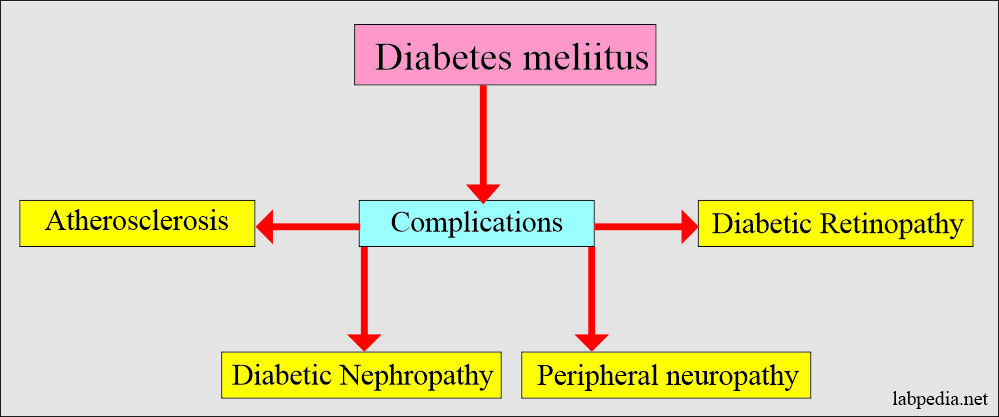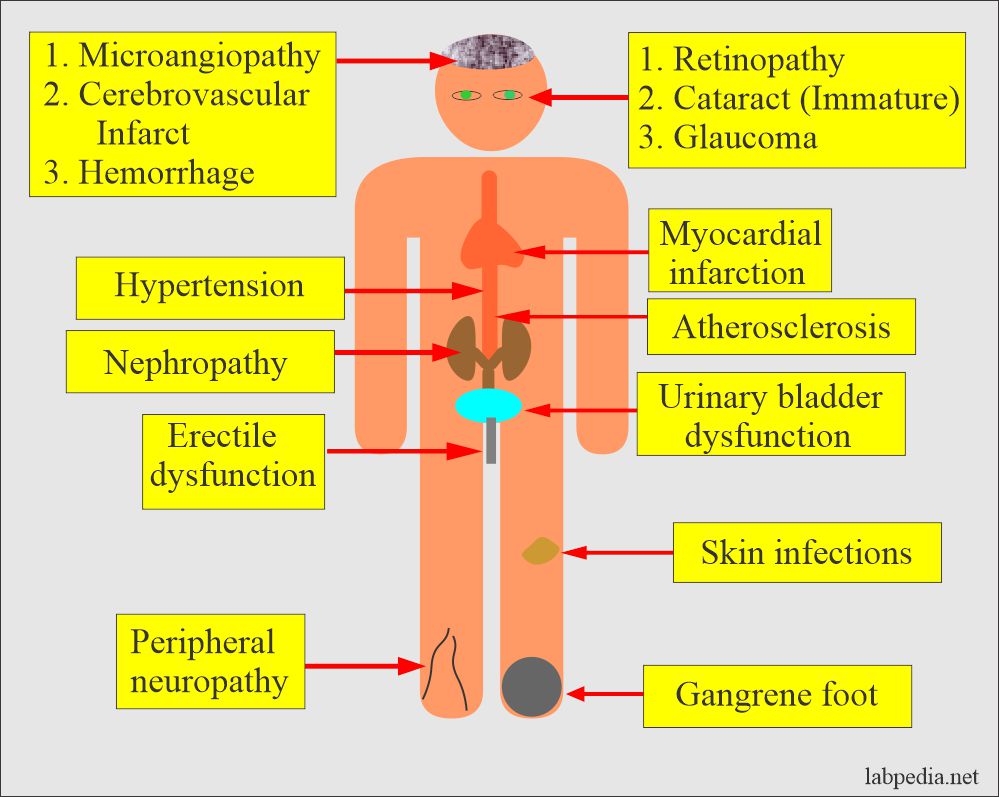Diabetes Mellitus:- Part 6 – Diabetes Mellitus Complications and Prevention
Diabetes Mellitus Complications
- Diabetic patients need follow-up and proper control to prevent diabetic complications.
What are the complications as the presenting signs/symptoms?
- Infections by staphylococcal.
- History of impotence.
- History of polyneuropathy, which will present as tingling and numbness of feet.
- Arterial disease results in acute myocardial infarction or gangrene of the foot.
- There is retinopathy, which is detected on examination by the eye specialist.
What will be the presentation of the complications of Diabetes Mellitus?
- There may be hypoglycemia.
- Patients with hyperglycemia of Type I, left uncontrolled, may develop life-threatening complications like diabetic Ketoacidosis.
- Without treatment, the patient may become acidotic and dehydrated and lose consciousness.
- Type II may develop hyperosmolar coma.
- Peripheral neuropathy.
- Diabetic retinopathy and cataract formation may lead to blindness.
- Cardiovascular microangiopathy.
- Coronary atherosclerosis.
- Myocardial infarction is 3 to 5 times more common in diabetic patients.
- AMI is the leading cause of death in diabetes mellitus type 2.
- Peripheral vascular diseases like ischemia of lower extremities, erectile dysfunction, and intestinal ischemia.
- Gangrene of the foot.
- Diabetic kidney diseases, diabetic nephropathy.
- It may lead to renal failure.
- Chronic pyogenic skin infection.
- Candidal infection of the skin.
- Bone and joints show contracture.
- In the end, maybe result in stroke, gangrene, and coronary artery diseases.
- These patients may have gum and mouth diseases.
How will you classify the diabetes mellitus complications?
What are the Acute complications?
Hypoglycemia:
- In the case of excess insulin injection and excess intake of alcohol, especially with an empty stomach, it can lead to hypoglycemia.
- Increased hypoglycemia risk includes autonomic neuropathy, gastroparesis, and end-stage chronic kidney disease.
- Hypoglycemia occurs in impaired glucagon response, sympathoadrenal responses, and cortical deficiency.
- Hypoglycemia can be classified as:
- Reactive, seen after eating.
- Fasting hypoglycemia is seen due to organic diseases like the liver, kidneys, pancreas, and deficiency of hormones.
- Combined, including reactive and fasting hypoglycemia.
Hyperglycemia:
- Patients with uncontrolled hyperglycemia of Type I diabetes mellitus may develop life-threatening complications like diabetic Ketoacidosis.
- Without treatment, the patient may become acidotic and dehydrated and lose consciousness.
- Type 2 diabetes mellitus may develop hyperosmolar coma.
- Hyperglycemia may be seen in:
- Diabetic ketoacidosis.
- Lactic acudosis.
- Alcoholic ketoacidosis.
- Hyperosmolar coma.
What are the Chronic complications?
- These lead to hypertension, end-stage chronic renal diseases, Blindness, autonomic and peripheral neuropathy, amputation of the lower limbs, myocardial infarction, and cerebrovascular accidents.
- Diabetic neuropathy:
- The most common is diabetic peripheral neuropathy, where the loss of function appears in a stocking-glove pattern and is due to an axonal neuropathic process.
- Foot motor and sensory nerve conduction are delayed in the peripheral nerves, and ankle jerk may be absent.
- Isolated peripheral neuropathy is the involvement of the distribution of one nerve. This is attributed to vascular ischemia or traumatic damage. Cranial and femoral nerves are more commonly involved.
- Autonomic neuropathy is seen in advanced and long-standing diabetes mellitus. This may involve visceral blood pressure, pulse, gastrointestinal activity, urinary bladder function, and erectile function.
- Peripheral neuropathy. There is the involvement of the cranial and peripheral nerves.
- Ocular complications:
- Premature cataracts occur in diabetics.
- There is retinopathy of two types; one is called nonproliferation, and the other is called proliferative retinopathy.
- Glaucoma occurs in 6% of diabetics.
- The involvement of small and large size blood vessels.
- Cardiovascular microangiopathy may explain the etiology of congestive cardiomyopathy in people with diabetes who don’t have evident coronary artery disease.
- Coronary atherosclerosis gives 3 to 5 times more myocardial infection in diabetics and is the leading cause of death in type 2 diabetes mellitus.
- Type 1 diabetes mellitus has also increased the risk of coronary artery disease. It is lower than type 2 DM.
- AMI is the leading cause of death in diabetes mellitus type 2.
- Peripheral vascular diseases like ischemia of lower extremities, erectile dysfunction, and intestinal ischemia.
- Gangrene of the foot.
- Diabetic nephropathy:
- 30% to 40% of type 1 diabetes Mellitus develop nephropathy over 20 years of diabetes.
- In type 2 diabetes, nephropathy is less common. Only 15 to 20% develop renal disease.
- Diabetic kidney disease (diabetic nephropathy) may lead to end-stage renal disease.
- Initially, there is proteinuria, followed by a decline in renal functions, increasing the blood urea and creatinine.
- This renal disease can be assessed by microalbuminuria.
- Also, advise the albumin/creatinine ratio.
- The albumin/creatinine ratio <30 is normal.
- The ratio of 30 to 300 mcg/mg suggests abnormal microalbuminuria.
- Chronic renal disease is suspected when persistent albumin excreted more than 30 mcg/mg creatinine.
- Patients develop nephrotic syndrome with hypoalbuminemia, edema, increased LDL-cholesterol, and increased azotemia when inadequate treatment.
- Ultimately, there is end-stage renal disease.
- Chronic pyogenic skin infection.
- Candidal infection of the skin. Also, there is vulvovaginitis in the female with uncontrolled diabetes mellitus.
- In type 2 poorly controlled diabetics, there are eruptive cutaneous xanthomas.
- Bone and joints show contracture.
- In chronic and long-standing diabetics, the hand’s progressive stiffness is secondary to the contracture and tightening of the skin over the joints (diabetic cheiroarthropathy).
- There may be frozen shoulders, which is adhesive capsulitis.
- There may be carpel-tunnel syndrome and dupuytyren-contracture.
- There may be hyperuricemia, and tophaceous gout is more common in type 2 diabetics.
Acute and chronic complications of diabetes mellitus:
| Acute complications | Chronic complications |
|
Vascular diseases
Nonvascular diseases
|
How will you prevent complications for diabetic patients?
- Basic metabolic panel:
- Fasting glucose level.
- Postprandial glucose level
- Microalbuminuria.
- BUN (urea).
- Creatinine.
- Electrolytes.
- Anion gap = (Sodium + potassium) — (Chloride + bicarbonate)
- HbA1c.
- Lipid profile:
- Cholesterol.
- Triglycerides.
- HDL.
- LDL.
- Check the urine regularly of all diabetic patients for microalbuminuria. The presence of proteinuria is the first sign of nephropathy.
- This can be slowed by antihypertensive therapy in case of hypertension.
- A renal biopsy may be done to evaluate kidney histology.
Questions and answers:
Question 1: What is the reason for gangrene of the foot in diabetics?
Question 2: How can you find the involvement of the kidney in diabetics?


